Appearing in a vast number of Whistler menus (including 2 July 1877) is ‘sole frite’. Mrs Beeton has a great deal to say on the subject of fish, from practical tips to a complete section on the “Natural History of fishes” in which, among other things, she praises “how simply, how wonderfully, the Supreme Being adapted certain means to the attainment of certain ends.” (it will be noted that this was published two years after On the origins of species) as well as running through the role of the fish in human history from the Greeks onward. But I fear we both digress… In Mrs Beeton’s estimation, sole “ranks next to the turbot in point of excellence among our flat fish” and the average cost is “from 1s. to 2s. per pair”. At the fish market in Leiden, sole prices ranged from €9.95 to €35 per kilo, but the price did not seem related to whether they appeared to have been used as ping-pong paddles before going on sale. Sometimes, these had top skin removed, which I always find disconcerting, as it makes freshness a bit harder to determine. Interestingly, Mrs Beeton offers an brief excursion on the subject of sole fishing, describing trawling.
HOW SOLES ARE CAUGHT.—The instrument usually employed is a trawl net, which is shaped like a pocket, of from sixty to eighty feet long, and open at the mouth from thirty-two to forty feet, and three deep. This is dragged along the ground by the vessel, and on the art of the fisherman in its employment, in a great measure depends the quality of the fish he catches. If, for example, he drags the net too quickly, all that are caught are swept rapidly to the end of the net, where they are smothered, and sometimes destroyed. A medium has to be observed, in order that as few as possible escape being caught in the net, and as many as possible preserved alive in it.
She of course, offers only concern for getting the fish to shore in one piece. Creating sustainable fisheries is another matter. Variations on these trawling methods are in use today, beam trawling and demersal otter trawling – each referring to different ways in which the net is held open and its interaction with the surface. While not necessarily devastating for sole stocks, both methods of fishing are not great in terms of by-catch. As such, getting sustainably caught flatfish is not always easy. In fact, it turns out I made a mistake, and opted for “sliptong” – which was both the cheapest and best-looking on offer. Four of them fit comfortably on a plate, and came in at just under 1lb. 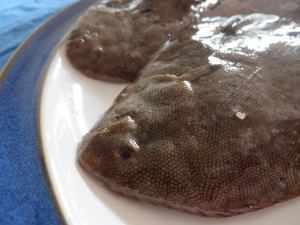
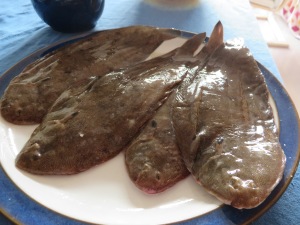 I had thought it was a different species (lemon sole), but then got home to discover that it is simply a small sole. Also called a ‘slip’ in English, because normally they slip through nets. Reading the Dutch fish guide, it became clear that this is almost certainly a sign of non-sustainable fishing. Our open fish markets could do a lot better with labelling origins and methods. It seems the supermarkets are doing a lot better at labelling – and sourcing – sustainable fish. but of course, then its freshness is a bit more of a question. The Dutch WWF has this to say (my translation from Dutch):
I had thought it was a different species (lemon sole), but then got home to discover that it is simply a small sole. Also called a ‘slip’ in English, because normally they slip through nets. Reading the Dutch fish guide, it became clear that this is almost certainly a sign of non-sustainable fishing. Our open fish markets could do a lot better with labelling origins and methods. It seems the supermarkets are doing a lot better at labelling – and sourcing – sustainable fish. but of course, then its freshness is a bit more of a question. The Dutch WWF has this to say (my translation from Dutch):
It is precisely slip that you should let swim! This is the smallest size of sole that may be landed. Brussels has set quotas not only for the number but also for the size of fish that may be landed. For sole this is 24cm. At that size, the fish has not even spawned! To catch these little fish, the fishers use nets with a small mesh (80mm). This means large bycatches; for every slip caught, 6 undersized plaice (that cannot be landed) are thrown overboard. About 60% of all sole that is landed are slips. That shows that there are too few adult sole in the sea; this makes restoring of their levels more difficult.
One indication of the change in size can be derived from the cookbook: For Mrs Beeton, two soles – even small ones – will feed 4-5 people and she also notes that the fine sole caught off Torbay frequently weigh 8-10 lbs per pair. Curiously, Mrs Beeton praises small sole as the tastiest. These days, it seems the rarity factor has made large ones the more preciosu. I was told while buying a large one (no more than half the size of the ones Mrs Beeton describes!) from a fishmonger in Utrecht “you normally only see big ones like this in fine restaurants.”
What’s in a name?
Sole frite = fried sole, right? Well, yes, but… I had assumed that this would have been something akin to the classic sole à la meunière: fish fried in butter, and served with a sauce of same. But here Whistler’s habit of writing out his menus in French leads to some issues of translation. In colloquial English now, frying pretty much means any stovetop method of cooking in fat – the depth of the fat makes no difference (if we need to specify, we refer to things as ‘deep-fried’ or ‘shallow-fried’). French is another matter: there is a distinction between sautoir – shallow-frying (we know the word sauté) and frire – to deep fry. What is translated as ‘frying’ in Escoffier refers to deep frying. Fish à la Meunière is another matter entirely. So which is it? A hint comes from Mrs Beeton – who has no recipes for shallow-frying sole at all. For her, fried sole is deep-fried:
FRIED SOLES.
327. INGREDIENTS.—2 middling-sized soles, hot lard or clarified dripping, egg, and bread crumbs.
Mode.—Skin and carefully wash the soles, and cut off the fins, wipe them very dry, and let them remain in the cloth until it is time to dress them. Have ready some fine bread crumbs and beaten egg; dredge the soles with a little flour, brush them over with egg, and cover with bread crumbs. Put them in a deep pan, with plenty of clarified dripping or lard (when the expense is not objected to, oil is still better) heated, so that it may neither scorch the fish nor make them sodden. When they are sufficiently cooked on one side, turn them carefully, and brown them on the other: they may be considered ready when a thick smoke rises. Lift them out carefully, and lay them before the fire on a reversed sieve and soft paper, to absorb the fat. Particular attention should be paid to this, as nothing is more disagreeable than greasy fish: this may be always avoided by dressing them in good time, and allowing a few minutes for them to get thoroughly crisp, and free from greasy moisture. Dish them on a hot napkin, garnish with cut lemon and fried parsley, and send them to table with shrimp sauce and plain melted butter.
Time.—10 minutes for large soles; less time for small ones
Seasonable at any time.
Sufficient for 4 or 5 persons.
So, deep-frying it was. If your fishmonger has not done so already, clean the sole, cut off the head, and skin the top (dark) side. You do this by making a small cut at the base of the tailfin with a sharp knife. Scrape up under the cut with the edge of the knife until you have enough skin to get a hold on, then just pull. The tough skin will come off and leave the flesh behind. With scissors, trim off the side fins (if you can be bothered). If your sole are large, you can follow Mrs Beeton’s advice and cut them into 2-3 pieces. 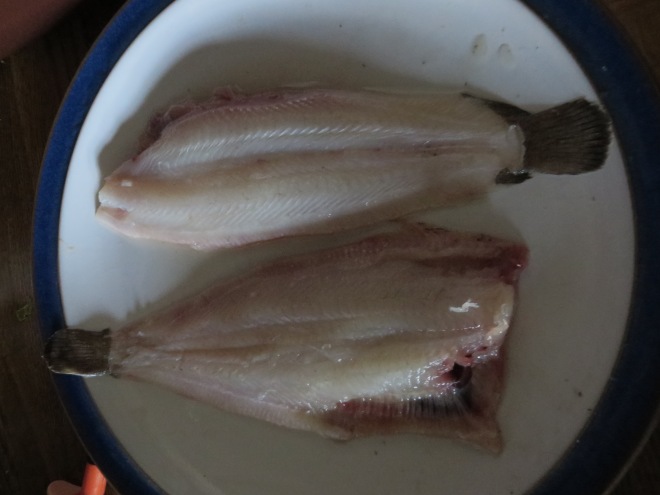 For deep-frying, it is important to get the fish as dry as possible to prevent oil spattering and too much steam. Once washed, pat them with kitchen roll…
For deep-frying, it is important to get the fish as dry as possible to prevent oil spattering and too much steam. Once washed, pat them with kitchen roll… 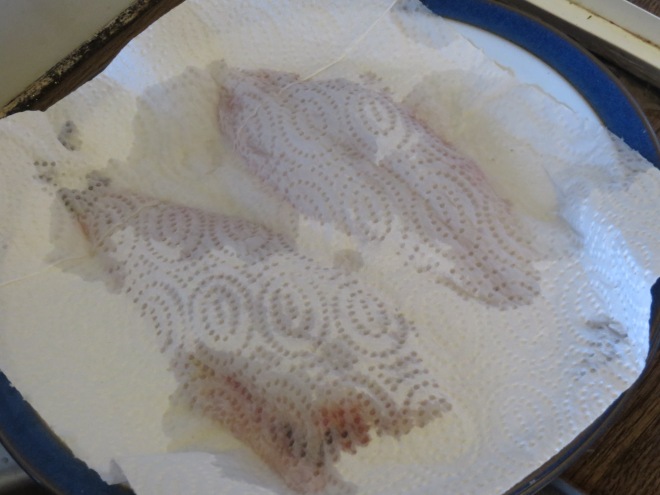 Heat oil in a deep pan (given that we only had two fish and limited oil we risked spattering and went for the cast-iron skillet. It went fine, but don’t try this at home). Heat the oil to 180-190C. While it is coming up to temperature, sprinkle fish with salt and pepper and dredge them in flour. As dry as they are, it will still stick. Either brush them or dip them in beaten egg, and then roll them in bread crumbs. When the oil is up to temperature, gently lower in the fish.
Heat oil in a deep pan (given that we only had two fish and limited oil we risked spattering and went for the cast-iron skillet. It went fine, but don’t try this at home). Heat the oil to 180-190C. While it is coming up to temperature, sprinkle fish with salt and pepper and dredge them in flour. As dry as they are, it will still stick. Either brush them or dip them in beaten egg, and then roll them in bread crumbs. When the oil is up to temperature, gently lower in the fish. 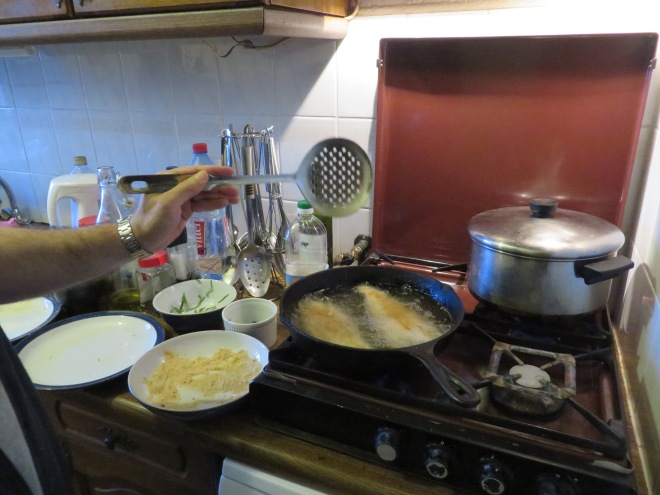 For smaller pieces, 3-2 minutes per side was plenty. The top side is under the oil as well, but does not cook as quickly, hence turning it over once. Mrs Beeton’s advice, that the oil should be smoking when you are done, may be safely ignored. However, do make sure your oil is hot enough – this will avoid it being over-greasy. By the time it is a deep golden-brown, the inside will still be very moist, the outside crispy and not soggy. Drain on more paper towel and keep warm in the oven, if you need to do another batch. “Garnish with cut lemon and fried parsley” Fried parsley is a common garnish in Escoffier as well as Mrs Beeton, and it does mean deep-fried. We did not have any instructions to hand, but I recalled fondly an episode in Robert Farrar Capon’s delightful culinary/theological treatise The Supper of the Lamb (Garden City, NY: Doubleday: 1967) in which he blithely cons his wife into serving persil frite at a dinner party, having never seen or eaten it himself. He even goes so far as to come up with a a technique of bundling the parsley in little napkin-ring like holders made out of sections of breadsticks cut with a coping saw.
For smaller pieces, 3-2 minutes per side was plenty. The top side is under the oil as well, but does not cook as quickly, hence turning it over once. Mrs Beeton’s advice, that the oil should be smoking when you are done, may be safely ignored. However, do make sure your oil is hot enough – this will avoid it being over-greasy. By the time it is a deep golden-brown, the inside will still be very moist, the outside crispy and not soggy. Drain on more paper towel and keep warm in the oven, if you need to do another batch. “Garnish with cut lemon and fried parsley” Fried parsley is a common garnish in Escoffier as well as Mrs Beeton, and it does mean deep-fried. We did not have any instructions to hand, but I recalled fondly an episode in Robert Farrar Capon’s delightful culinary/theological treatise The Supper of the Lamb (Garden City, NY: Doubleday: 1967) in which he blithely cons his wife into serving persil frite at a dinner party, having never seen or eaten it himself. He even goes so far as to come up with a a technique of bundling the parsley in little napkin-ring like holders made out of sections of breadsticks cut with a coping saw.
What followed was the nearest thing we have ever had to a kitchen fire, and one of the nearest to a marital disaster. Parsley: freshness: water. All life is from the sea. Water: heat: steam. When the bouquets hit the fat, the whole business blew up. Steam: sound: fury. And grease all over the kitchen. Fury: wife: tears. All waters return to the sea.
But we gave it a go anyway – surely Escoffier and Mrs B. can’t both be insane. Plus, Father Capon offers an intriguing epilogue to his tale of hubris: “To this day I remember nothing about the rest of the meal. Except this one thing: the parsley was glorious.” So, forgoing any coping-saw antics, assuming the burden of folly on my own shoulders – and getting Kathy to watch from a safe distance to avoid marital strife – I gave it a go. Wash and gently but carefully dry several sprigs of parsley. Place them at the end of a slotted utenstil with a long handle and lower them carefully into the hot oil. They will steam, bubble and spit. As soon as the fury dies down – after about 10 seconds – pull them out. 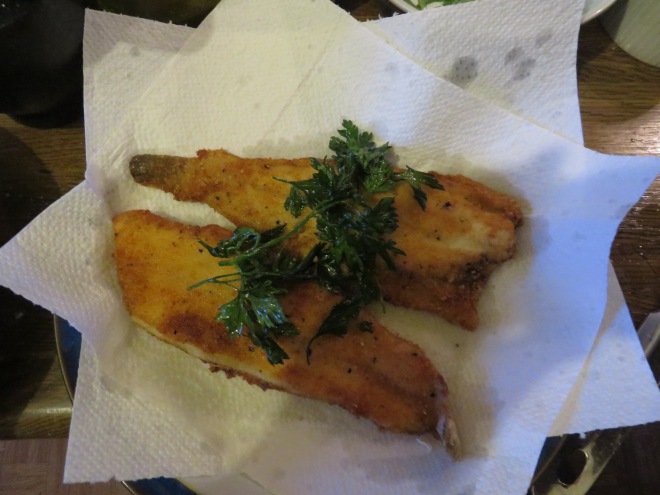
“It fries in ten seconds or so and turns the most stunning green you can imagine.” (Capon 1967 p. 19)
Shhhhh! We were left with breadcrumbs, flour and a bit of egg, so I thought what any (even part-time) Southerner would: hushpuppies. Hushpuppies are traditionally leftover bits of batter – supposedly then thrown to the dogs who didn’t get any of whatever else you were frying, hence the name. Most recipes have some kind of leavening in, and are usually cornmeal-based. Here, I just chucked all remaining batter ingredients together in a bowl, had a quick stir, and dropped tablespoon-sized balls of the resulting scone-consistency dough into the oil as well, and fried until brown. I was actually surprised at how moist, tender and downright tasty they turned out to be. I can’t imagine Whistler actually having something like this come to the table – but who says it had to? They can be the cook’s little secret snack. I am sure they would go nicely with whatever Mrs. Cossins was drinking… 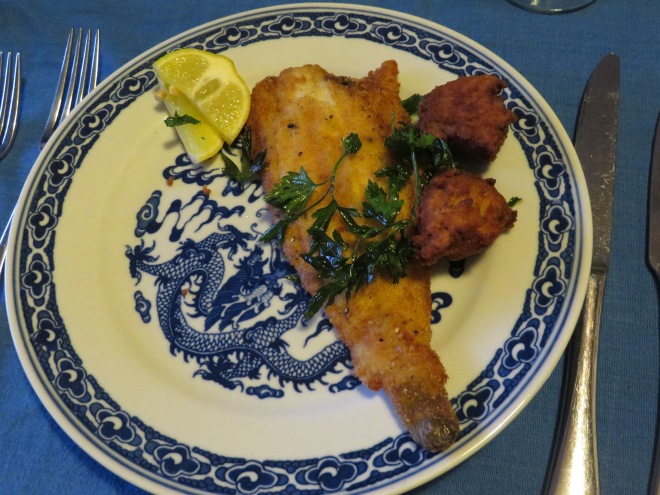
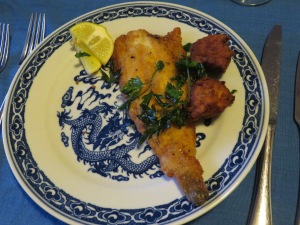
2 thoughts on “Sole Frite”